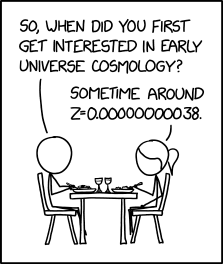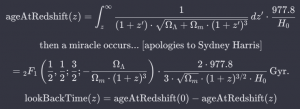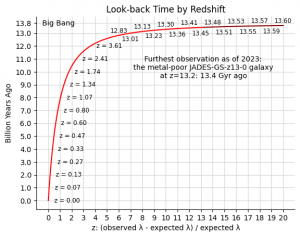2853: Redshift
| Redshift |
 Title text: So do you have any plans for z=-0.000000000000045? |
Explanation[edit]
In this comic, Ponytail is using cosmological terms to answer that she first got interested in early universe cosmology 5.4 years ago, to which Cueball asks (in the title text) whether she has plans five and a half hours later. One interpretation is that these are two colleagues out for lunch, and Cueball likes her nerdy answer so much he wants to ask her out for a dinner date after work.
In observational cosmology, a field of astronomy, redshift refers to the way that light from distant objects in the universe is stretched out, making it appear more red than it would otherwise. This occurs because the universe is expanding, and as a result, light waves are stretched as they travel through space. The "z" value is a dimensionless measure of the redshift: the observed wavelength minus the expected wavelength, divided by the expected wavelength. A higher "z" value, or redshift, corresponds to earlier times in the history of the universe. This is because as the universe expands, light from distant galaxies is stretched to longer, redder wavelengths as it travels towards us. The further away a galaxy is, the longer its light has been traveling, and thus the more the universe has expanded since that light began its journey. Therefore, a higher redshift indicates a galaxy that is further away and that the light we see from it left when the universe was younger. Conversely, a lower redshift means the light has traveled a shorter distance and time, indicating a more recent epoch in the history of the universe. Negative values of "z" indicate a blueshift, which indicate objects that are approaching the observer, generally used in cosmological work to calculate rotation speeds of closer objects.
The joke here is that Cueball is asking Ponytail when she became interested in cosmology, and instead of giving a conventionally referenced time (such as "in college", "as a kid", "in 2020" or "seventeen years ago", whatever may apply), she responds with a redshift value "z=0.00000000038". This very small number corresponds to a very recent event compared to the start of the universe; well within a human lifetime, though it might take a cosmologist's specific knowledge to understand this and work out the interval's value. The negative blueshift question in the title text is a playful way of similarly asking about a future event. As the absolute value of the negative z is about ten thousand times smaller, it indicates a much closer event in the future.

Assuming a given cosmology, its curvature, and a value for the Hubble parameter H0 (also called the Hubble constant), it is possible to derive a specific look-back time for any given redshift value. For z=0.00000000038, a flat Lambda-CDM cosmological model with H0 = 69.32 km / Mpc / s (a reasonable medium between the disparate "crisis in cosmology" values for the Hubble parameter), a value of Ω0 of 0.2865, and a cosmic background temperature of 2.725 K, the look-back time is about 1960 days, or 5.4 years, which could suggest that Ponytail started studying cosmology as part of a Ph.D. program. Negative numbers of z, such as in the title text, would indicate a "look-forward" time, or a time in the future, and the same model indicates that z=-0.000000000000045 corresponds to 5.5 hours in the future. So Cueball is likely asking something like "What are you thinking of doing (later) this evening?"
The use of non-standard units of measurement has also been seen in 2707: Astronomy Numbers, with much larger typical redshift values previously included in 2764: Cosmological Nostalgia Content. Redshift and blueshift have also been mentioned before in 1852: Election Map.
Transcript[edit]
- [Cueball and Ponytail are sitting at a table, eating from plates in front of them, Cueball using both hands with cutlery, Ponytail only holding cutlery in one hand, the other hand lying on her lap. Each has a wine glass standing on the table between the plates.]
- Cueball: So, when did you first get interested in early universe cosmology?
- Ponytail: Sometime around z=0.00000000038.
Discussion
Does it make any sense to try and relate the two Z values to a more "normal" time? MAP (talk) 21:08, 10 November 2023 (UTC)
I have added exactly that, using `astropy.cosmology` for the calculations Juandesant (talk) 21:16, 10 November 2023 (UTC)
There is a big error in the current explanation, saying it means they were interested in this since the early universe, but that would only be true if the z value was much closer to 1. I'm not exactly sure as I haven't done the math, but with that many decimal places of zero's it is probably near enough history to be during their lifetime. So the joke isn't being interested in the early universe since the early universe, but rather so interested in it that they talk about other things with the same terminology.--172.70.126.142 21:18, 10 November 2023 (UTC)
Why aren't these values expressed in scientific notation? Separately, do they make sense logarithmically? JohnHawkinson (talk) 07:12, 11 November 2023 (UTC)
- Part of the joke is that the values are unwieldy to use compared to everyday language and units. The scientific notation would have lessened this. However they are given in a universal standard time instead of some solar system or human related units, so they generally should be clearly preferred. Sebastian --172.68.110.188 15:37, 11 November 2023 (UTC)
I feel like the Earth's gravitational field would affect the answer as z goes to zero? 172.69.22.210 06:57, 12 November 2023 (UTC)
Calculation[edit]
Thanks to ChatGPT-4 and the Fortran-90 code from arxiv:1303.5961 (which please see, it's really cool) here's how to get the look-back time from redshift in Python:
from scipy.special import hyp2f1 # hypergeometric function 2F1 is in integral solution
from numpy import format_float_positional
# Cosmological parameters from the Fortran params.f90 header
#H0 = 67.15 # Hubble constant in km/s/Mpc (or, 73.5: the "crisis in cosmology")
H0 = 69.32 # from Explainxkcd for 2853: Redshift; seems a consensus compromise
#OL = 0.683 # Cosmological constant for dark energy density, Omega_Lambda or _vac
#Om = 0.317 # Density parameter for matter, Omega_mass
Om = 0.286 # From https://arxiv.org/pdf/1406.1718.pdf page 8
OL = 1.0 - Om - 0.4165/(H0**2) # flat curvature, from https://www.astro.ucla.edu/~wright/CC.python
# (on https://www.astro.ucla.edu/~wright/CosmoCalc.html which see)
#print(f"{OL=:.3F}") # 0.714
# Age of universe at redshift z as a closed-form solution to its integral definition,
def age_at_z(z): # ...which is 27 times faster than the original numeric integration
hypergeom = hyp2f1(0.5, 0.5, 1.5, -OL / (Om * (z + 1)**3))
return (2/3) * hypergeom / (Om**0.5 * (z + 1)**1.5) * (977.8 / H0) # 977.8 for Gyr
# Current age of the universe at redshift 0 in Gyr
age0 = age_at_z(0) # 13.78
# Function to calculate the look-back time at redshift z in Gyr
def zt(z): # from the function name in the Fortran cosmonom.f90 code
return age0 - age_at_z(z)
# For z = 0.00000000038
z1 = 0.00000000038
look_back_time_years_z1 = zt(z1) * 1e9 # from Gyr to years
print("Look-back time for z=" +
f"{format_float_positional(z1)}: {look_back_time_years_z1:.1f} years")
# For z = -0.000000000000045
z2 = -0.000000000000045
look_back_time_hours_z2 = zt(z2) * 1e9 * 365.25 * 24
print("Look-back time for z=" +
f"{format_float_positional(z2)}: {look_back_time_hours_z2:.1f} hours")
The output being:
Look-back time for z=0.00000000038: 5.4 years Look-back time for z=-0.000000000000045: -5.5 hours
And should you wish to make this quick reference chart for interpreting observations in the JWST era:
| Supplemental code for Look-back Time by Redshift chart |
|---|
import matplotlib.pyplot as plt
import matplotlib.ticker as ticker
rs = [z * 20 / 299 for z in range(300)] # redshifts 0 to 20 in 300 steps
lb = [zt(z) for z in rs] # look_back_times
fo = 13.2 # furthest observation at present
#print(age_at_z(fo)) # 0.3285
plt.plot([x for x in rs if x<fo], [y for x,y in zip(rs,lb) if x<fo], color='red')
plt.plot([x for x in rs if x>fo], [y for x,y in zip(rs,lb) if x>fo], color='darkred')
plt.text(13.2, 9.5, 'Furthest observation as of 2023:\n' +
'the metal-poor JADES-GS-z13-0 galaxy\nat z=13.2: 13.4 Gyr ago', ha='center')
plt.title('Look-back Time by Redshift')
plt.xlabel('z: (observed λ - expected λ) / expected λ')
plt.ylabel('Billion Years Ago')
plt.xticks(range(21))
plt.yticks(list(range(14)) + [age0])
plt.text(-0.5, 13.78, "Big Bang", va='center')
plt.gca().yaxis.set_major_formatter(ticker.FormatStrFormatter('%.1f'))
plt.grid(True, color='lightgray')
plt.gca().spines['right'].set_visible(False)
plt.gca().spines['top'].set_visible(False)
for t in range(0, 13):
z = rs[min(range(len(lb)), key=lambda i: abs(lb[i]-t))]
plt.text(z, t, f" z = {z:.2f}", ha='left', va='center', fontsize='small')
for z in range(7, 20, 2):
t = zt(z)
plt.text(z, t - 0.2, f"{t:.2f}", ha='center', va='top', fontsize='small')
for z in range(6, 21, 2):
t = zt(z)
plt.text(z, t + 0.1, f"{t:.2f}", ha='center', va='bottom', fontsize='small')
plt.savefig('time_by_redshift.png', bbox_inches='tight')
#plt.show() # https://i.ibb.co/LpdYXNx/time-by-redshift.png
|
Or this one showing the age of the universe from redshift:
| Supplemental code for Age of Universe by Redshift chart |
|---|
plt.clf() # Reset plot
rs = [z * 15 / 299 + 5 for z in range(300)] # redshifts 5 to 20 in 300 steps
ages = [age_at_z(z) * 1000 for z in rs] # Gyr to million years
plt.plot([x for x in rs if x<fo], [y for x,y in zip(rs,ages) if x<fo], color='red')
plt.plot([x for x in rs if x>fo], [y for x,y in zip(rs,ages) if x>fo], color='darkred')
plt.text(13.2, 650, 'Furthest observation as of 2023:\n' +
'the metal-poor JADES-GS-z13-0 galaxy\nat z=13.2: age 329 Myr', ha='center')
plt.title('Age of Universe by Redshift')
plt.xlabel('z: (observed λ - expected λ) / expected λ')
plt.ylabel('Million Years')
plt.xticks(range(5, 21))
plt.yticks(range(0, 1300, 100))
plt.grid(True, color='lightgray')
plt.gca().spines['right'].set_visible(False)
plt.gca().spines['top'].set_visible(False)
plt.savefig('age_by_redshift.png', bbox_inches='tight')
#plt.show() # https://i.ibb.co/C537rxJ/age-by-redshift.png
|
P.S. Some commentary from ChatGPT-4 about the special Gaussian hypergeometric function hyp2f1 in the closed-form solution of the integral:
The appearance of the hypergeometric function 2F1 in the solution for the age of the universe as a function of redshift is a profound example of the interconnectedness of mathematical functions and physical phenomena. The hypergeometric function, which encompasses a vast family of functions, can describe a wide range of behaviors and has properties that make it particularly suited to representing solutions to differential equations that arise in physics.
In the context of cosmology, the use of 2F1 in calculating the age of the universe from redshift is not just a mathematical convenience but rather a reflection of the underlying physics. The Friedman equations, which govern the expansion of the universe, are derived from General Relativity and lead to solutions involving integrals that can express the evolution of the universe's scale factor over time. When these integrals are solved, they often involve special functions like 2F1, which encode information about the geometry of the universe and the relative contributions of matter, radiation, and dark energy.
The presence of 2F1 in this solution indicates that the relationship between the age of the universe and redshift is non-linear and depends on the integral of a function that encapsulates the dynamics of cosmic expansion. It's also worth noting that special functions like 2F1 often have interesting properties, such as symmetry and recurrence relations, which sometimes allow physicists to gain insights into the behavior of the universe under different conditions or scales.
Furthermore, solutions involving 2F1 are not merely academic exercises; they can be compared with observational data, such as measurements of the cosmic microwave background radiation, distributions of galaxies, or supernovae light curves. These comparisons can test the validity of our cosmological models and potentially offer new insights into the nature of dark energy and dark matter, the curvature of the universe, and other fundamental questions in cosmology.
In summary, the use of 2F1 in the closed-form solution for the age of the universe from redshift is a powerful reminder that mathematics provides us with the tools to decode the cosmos, offering deeper understanding and raising new questions about the fundamental structure and evolution of the universe.
Liv2splain (talk) 19:25, 14 November 2023 (UTC)
A further simplification: hyp2f1(0.5, 0.5, 1.5, z**2) = arcsin(z) / z. 172.69.150.141 (talk) 13:43, 17 November 2023 (please sign your comments with ~~~~)
- -OL / (Om * (z + 1)**3) is not z**2. 172.70.210.234 10:09, 22 July 2024 (UTC)
 Add comment
Add comment

